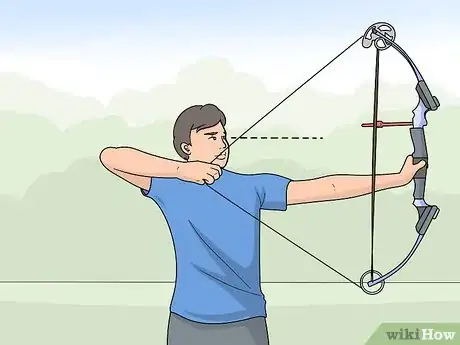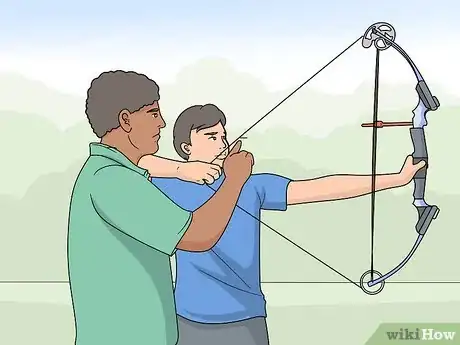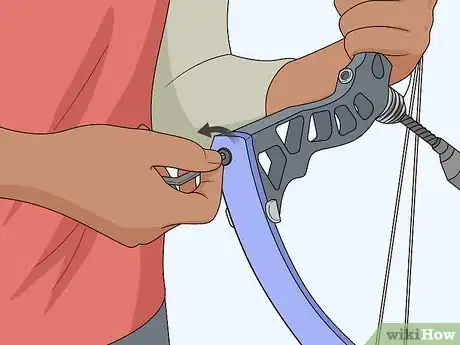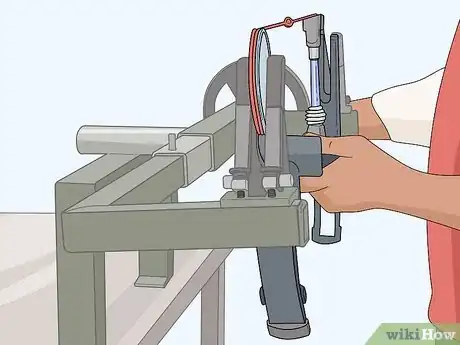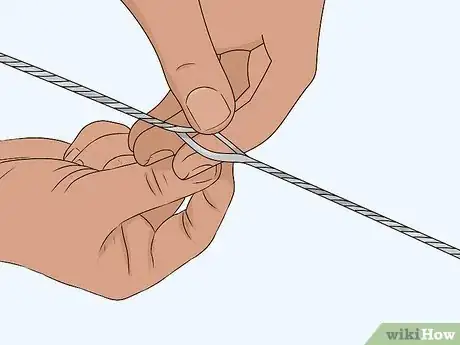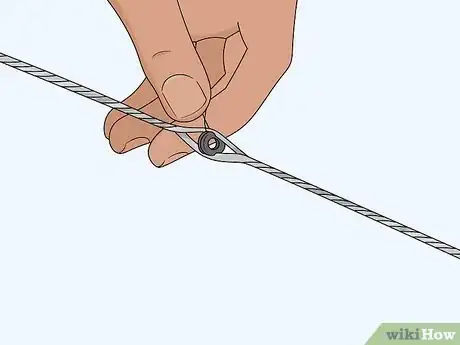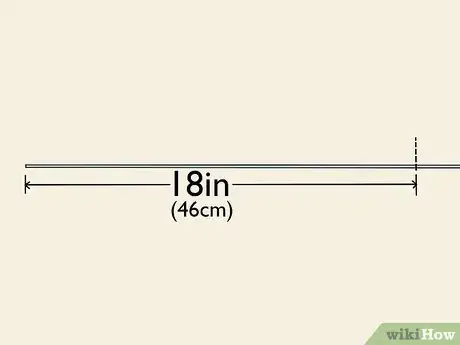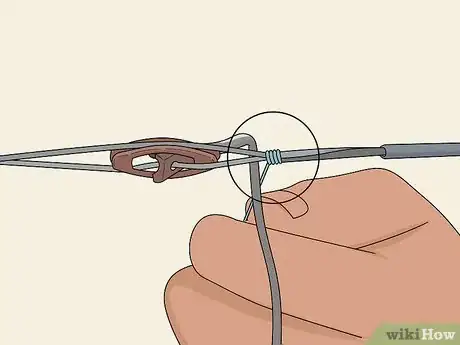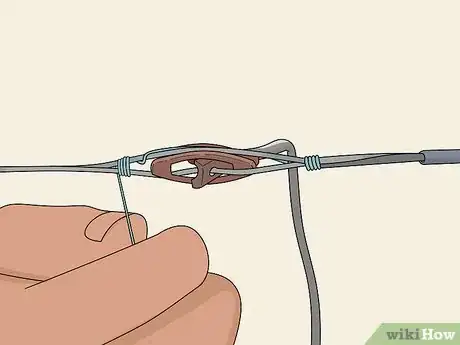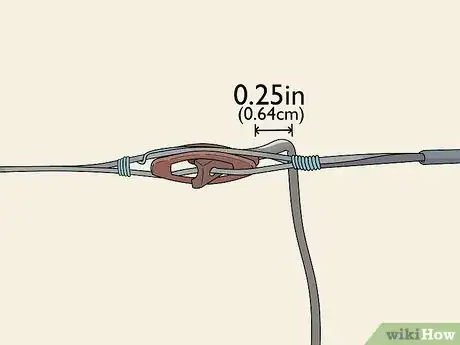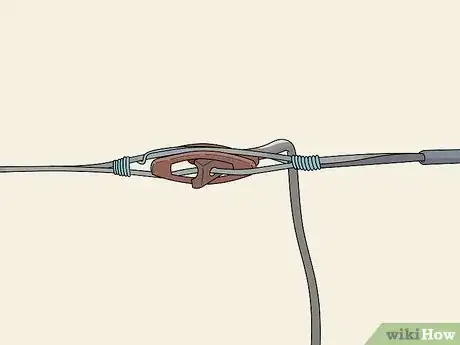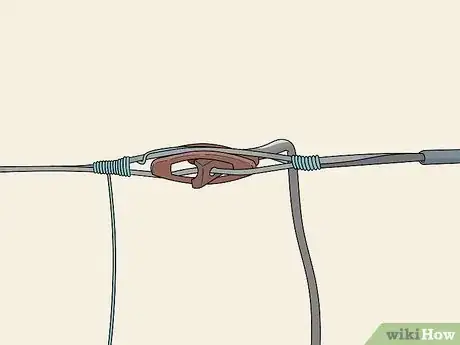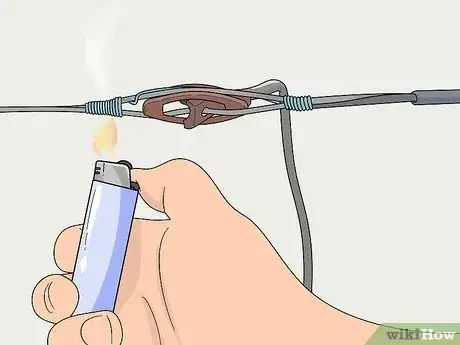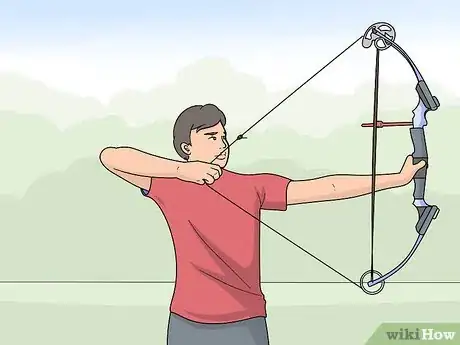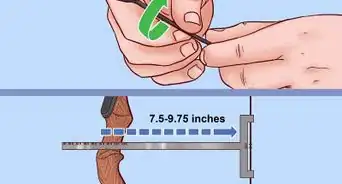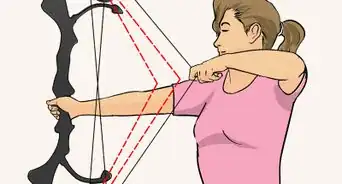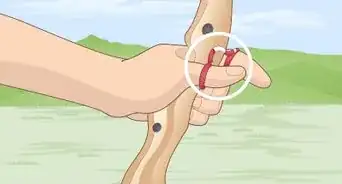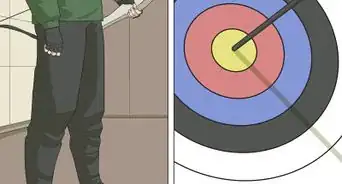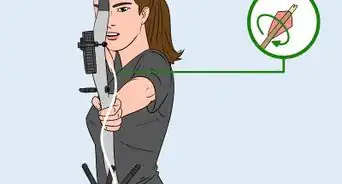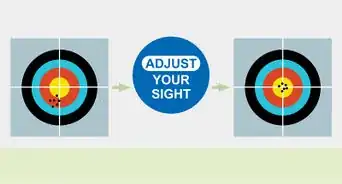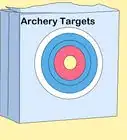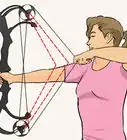This article was co-authored by wikiHow staff writer, Christopher M. Osborne, PhD. Christopher Osborne has been a wikiHow Content Creator since 2015. He is also a historian who holds a PhD from The University of Notre Dame and has taught at universities in and around Pittsburgh, PA. His scholarly publications and presentations focus on his research interests in early American history, but Chris also enjoys the challenges and rewards of writing wikiHow articles on a wide range of subjects.
There are 9 references cited in this article, which can be found at the bottom of the page.
This article has been viewed 29,120 times.
Learn more...
In archery, a peep sight (often just called a “peep”) is an aiming aid that’s attached directly to the bowstring of a compound or recurve bow. “Peeping” through the sight while the bow is drawn helps you determine where your arrow will end up. After having a friend help you mark the ideal spot for your peep, reduce the tension on your bowstring with a bow press and start the process of “serving in the peep” (that is, using “serving string” to tie the peep in place). After a fair bit of wrapping, tying, and finishing touches, you’ll be ready to use your peep to hit that elusive bull’s eye!
Steps
Marking the Spot for the Peep
-
1Nock an arrow and draw the bow as normal. With the bow pointed downward, slip the nock at the back of the arrow over the bowstring. Grasp the rear of the arrow with with 3 fingers, then pull back as you raise the bow.[1]
- It’s more common to add a peep sight to a compound bow, but you can also add one to a recurve bow in the same manner.
-
2Position yourself like you’re aiming at a target straight ahead. Stand up straight with your feet at shoulder width and your body positioned perpendicular to your imagined target. Keep your elbows parallel to the ground as you draw the bowstring fully back to your typical reference point—you might, for instance, draw back until your thumb brushes your cheek, chin, ear, or nose. Focus your eyes on your imaginary target.[2]
- If you’re having trouble envisioning an imaginary target, go out on the range and aim at a real target.
Advertisement -
3Have a friend mark the bowstring where it’s level with your eye’s pupil. They need to stand at your side so that the drawn bow is between the two of you and the arrow is pointed perpendicular to your bodies. Ask them to imagine a straight line running from the bowstring to the pupil of your eye that’s closest to it. Have them mark this spot on the bowstring with a permanent marker.[3]
- It’s important to maintain your normal shooting position while the other person marks the location for the peep. Otherwise, the peep won’t be in the right spot when you are ready to shoot.
- Make sure your friend never stands anywhere near the arrow's potential flight path.
- Slowly lower the bow and reduce the tension on the bowstring after your friend marks the spot for the peep.
Inserting the Peep
-
1Reduce full tension on your bow string with an allen wrench, if possible. Insert an allen wrench into the appropriate slot at the tip of one bow arm, make 2 full counterclockwise turns, and repeat on the other bow arm. This type of fine-tuning is available with nearly all compound bows and some models of recurve bows.[4]
- Check the owner’s manual to confirm how to do this fine-tuning for your particular bow model.
- Skip this step and move on to using a bow press if your bow does not permit this type of fine-tuning.
-
2Loosen the bow string tension further by using a bow press. A bow press is essentially a large clamp that squeezes the bow’s arms in slightly in order to reduce the tension on the bowstring. Insert your bow horizontally into the press according to your press model’s instructions, then tighten the press (often by turning a wheel) until there is light slack on the bowstring—you should be able to easily lift the string 1 in (2.5 cm) with 2 fingers.[5]
- Inserting a peep properly requires the use of a bow press. While you can search online for examples of DIY bow presses that may work for you, it’s likely a worthwhile investment to purchase a bow press. Alternatively, see if a fellow archer or repair shop has a bow press you can use.
- Low-end bow presses cost around $50 USD, while high-end models can sometimes cost around $500. Ask knowledgeable archers if there are particular models they recommend or discourage.
-
3Separate the 2 intertwined strands of the bowstring at the marked spot. Modern bowstrings are made up of 2 intertwined strands which are usually different colors. Wedge the tip of a bowstring separator tool between the strands right where your friend put the marker spot. Remove the tool and use your fingers to keep the strands separated.[6]
- Check at your local archery shop or do an online search for “bowstring separator tool.”
- Bowstring separator tools usually cost less than $10 USD and are less likely to damage the bowstring than DIY options like a dull butter knife.
-
4Slide the peep between the strands with the notches aligned. A modern peep is typically a small plastic tube that has a central channel running around its outer circumference, as well as 2 notches that run nearly perpendicular to the central channel. Use one hand to keep the bowstring strands spread apart. Use your other hand to insert the peep between the strands so that they slide into the notches when you release tension on the strands.[7]
- There are other types of peeps, some with subtle or even significant design differences, so refer to the specific product instructions whenever installing any type of peep.
Tying the Peep into the Bow String
-
1Cut a length of serving string that's approximately 18 in (46 cm). Serving string is a thin synthetic thread designed specifically for archery equipment. Unroll the amount you need—estimating more rather than less—and cut it off with scissors.[8]
- Pick up serving string at any archery supply store or online.
- Do not use other types of thread or fishing line. They aren’t made for this job!
-
2Wrap the line 4 times around just one of the bowstring threads, then pull it tight. Start the wrap about 1 in (2.5 cm) either above or below the peep’s location. Leave about a 0.5 in (1.3 cm) “tail” of line when you make the first wrap around the thread. Fold the tail down against the thread and wrap the line over its own tail and the thread 3 times.[9]
- Pull the 4 wraps tight by pulling on the tail with a pair of needle-nose pliers and pulling on the free end of the string with your fingers—or, better yet, a second pair of needle-nose pliers.
-
3Wrap the line 4 times around both threads, then tighten the wraps again. Lift the tail of thread out of the way this time instead of wrapping over it. After going around both threads of the bowstring 4 times, pull the wraps tight with pliers again.[10]
-
4Wrap 4 times, pull, and repeat until you’re 0.25 in (0.64 cm) or closer to the peep. Aim to get as close to the peep as you can while still being able to cinch both strands of the bowstring together with the wraps of string. If you can make it all the way to the peep, that’s great, but getting within 0.25 in (0.64 cm) is sufficient to securely hold the peep in place.[11]
-
5Run the string to the other side of the peep and make 2 tight wraps. Pull the string taut and run it past the peep and to the other side—above the peep if you started wrapping below it, or vice versa. Make one wrap around a single bowstring thread on this other side of the peep. Then, make a single wrap around both bowstring threads and pull the wraps tight.[12]
- Start the wraps on the second side so that they mirror those on the first side. That is, if the wraps got to within 0.125 in (0.32 cm) of the peep on the first side, make the first wrap on the second side starting at 0.125 in (0.32 cm) from the peep.
-
6Keep wrapping and pulling until the wraps on both sides of the peep are equal. As before, make 4 wraps around both threads, pull them tight with pliers, and repeat. You don’t need to end up with the exact same number of wraps on both sides of the peep, but aim for the wraps to cover the same length on the bowstring.[13]
-
7Tie your preferred secure knot with the remaining length of string. You can tie the free end of the string using several single or double overhand knots, a whip finish knot, or another type of secure knot that you’re comfortable tying.[14] It’s really just a matter of personal preference.
- The knot should hold on its own, but you’ll also be adding some finishing touches to ensure that the wraps stay in place.
Securing and Testing the Peep
-
1Trim both free ends of the serving string to 0.125 in (0.32 cm) in length. Use either sharp scissors or a razor blade for the job. Don’t try to cut the free ends completely flush with the wraps of string; instead, leave very short stubs of free string at each end.[15]
-
2Apply super glue to the serving string stubs for a quick seal. There are 2 options here—gluing the stubs or melting them—and gluing is a bit easier. Work carefully so that you apply just a single drop right where each stub meets the wraps of string. Let the glue dry for the product's recommended drying time (often around 1-2 minutes) before proceeding.[16]
- Try your best not to get any super glue on either the peep or the bowstring threads, as it may impact your bow’s performance.
- A typical small squeeze bottle of super glue, which you can get from a wide range of retail outlets, is fine for this application.
-
3Melt the stubs with a lighter’s flame for a nicer looking seal. Gluing the stubs gets the job done, but melting them in place looks more professional. Carefully position the lighter so that the flame just barely laps at one of the stubs. Pull the lighter away once you see the synthetic material that makes up the stub start to deform, wait 2 seconds, then use your finger to squash the stub down against the wraps of string. Repeat with the other stub.[17]
- It’s very easy to damage your bowstring threads by getting an open flame too close to them. Work very cautiously here, because you’ll likely have to replace your entire bowstring it you singe one of the threads.
-
4Release the tension and remove your bow from the bow press. If you turned a wheel clockwise to tighten the press against your bow, turn the wheel counterclockwise to free your bow from the press. Otherwise, follow the specific product instructions for your model of bow press.[18]
- If you slightly lessened the tension on your bow string with an allen wrench before putting the bow into the press, make sure to reverse the process after removing the bow from the press. If, for example, you made 2 full counterclockwise turns at the end of each bow arm previously, make 2 full clockwise turns of the allen wrench at the end of each bow arm now.
-
5Draw the bow using proper technique and confirm the location of the peep. When you nock an arrow and draw the bow fully as normal, you should be able to look straight through the opening in the peep sight. If necessary, you can make very minor adjustments to the peep’s location by nudging it up or down a minuscule fraction of an inch/centimeter.[19]
- If you followed every step along the way carefully, the peep should be in just the right position. If it's out of place and minor adjustments don't help, take your bow to an archery shop and have a professional remove and re-position the peep.
Things You’ll Need
- Bow press
- Allen wrench
- Bowstring separator tool
- Serving string
- Needle-nose pliers
- Scissors or razor blade
- Lighter or super glue
References
- ↑ https://www.americanhunter.org/articles/2010/5/20/how-to-install-peep-sight-and-nock-point/
- ↑ https://www.americanhunter.org/articles/2010/5/20/how-to-install-peep-sight-and-nock-point/
- ↑ https://www.americanhunter.org/articles/2010/5/20/how-to-install-peep-sight-and-nock-point/
- ↑ https://youtu.be/NonjWwC9O7A?t=120
- ↑ https://youtu.be/NonjWwC9O7A?t=120
- ↑ https://www.americanhunter.org/articles/2010/5/20/how-to-install-peep-sight-and-nock-point/
- ↑ https://youtu.be/wla7C3v07JM?t=200
- ↑ https://youtu.be/skKp0MJ11fc?t=130
- ↑ https://youtu.be/skKp0MJ11fc?t=130
- ↑ https://youtu.be/skKp0MJ11fc?t=130
- ↑ https://youtu.be/skKp0MJ11fc?t=190
- ↑ https://youtu.be/skKp0MJ11fc?t=230
- ↑ https://youtu.be/skKp0MJ11fc?t=230
- ↑ https://youtu.be/skKp0MJ11fc?t=290
- ↑ https://youtu.be/vH8T3JcHWJY?t=270
- ↑ https://youtu.be/vH8T3JcHWJY?t=270
- ↑ https://youtu.be/skKp0MJ11fc?t=490
- ↑ https://youtu.be/NonjWwC9O7A?t=120
- ↑ https://www.americanhunter.org/articles/2010/5/20/how-to-install-peep-sight-and-nock-point/
